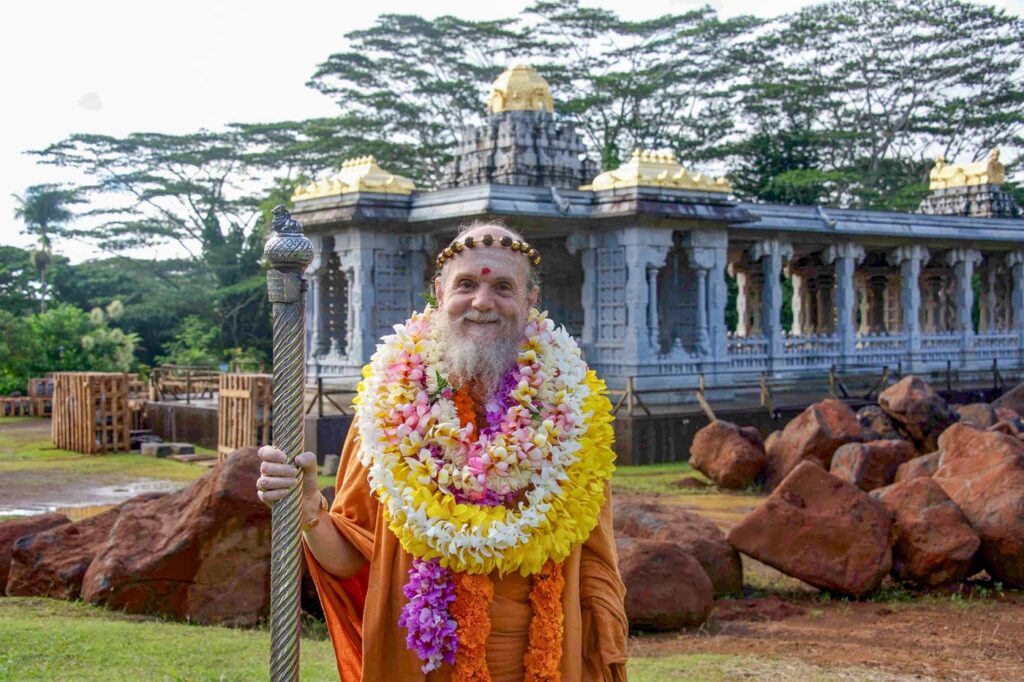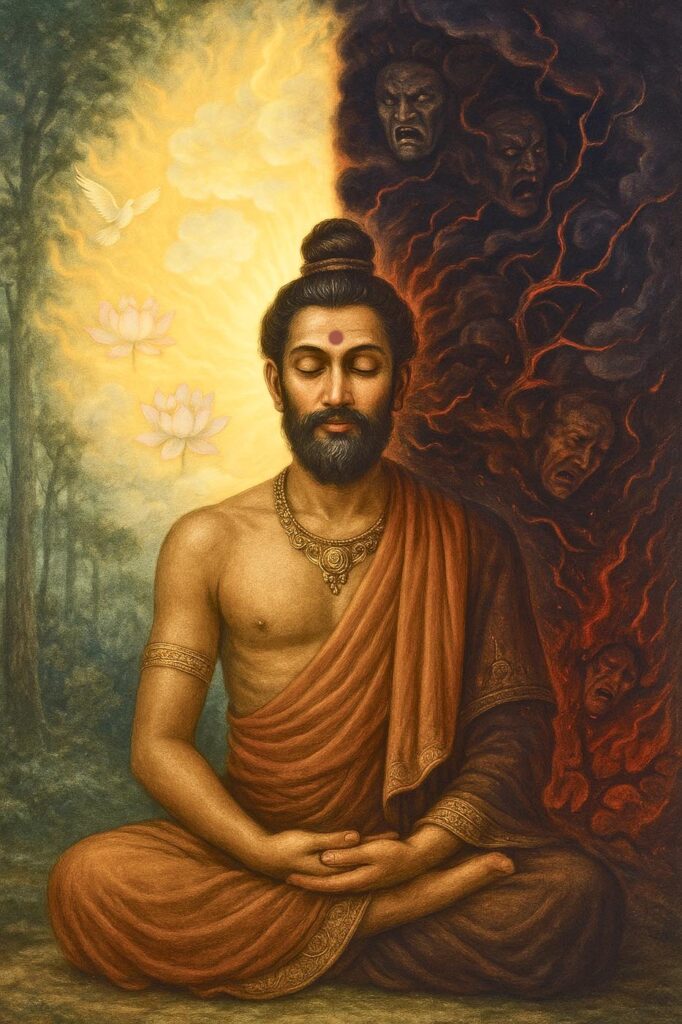Hinduism offers methods to secure spiritual consciousness by purifying the mind and quieting the thraldom of thought
By Satguru Bodhinatha Veylanswami

Let’s begin with a broad question: “What exactly distinguishes someone who believes in a religion—a religionist—from someone who doesn’t—a secularist?”A religionist typically believes that each person has a soul, an essence that continues to exist after death. A secularist generally believes that when the body dies, that’s the end—there’s nothing that survives the death of the physical form.
Going a bit deeper: a religionist also believes that what happens to the soul after death depends on how a person lived. If their actions were virtuous, the soul goes to a place some call heaven. If their actions were not virtuous, the soul experiences what is referred to as hell.
The Hindu Viewpoint
Hinduism shares several similar beliefs. Yes, the soul survives the body, and, yes, there are experiences after death, which can be likened to heaven and hell. But it adds something unique—something profound. It tells us that these aren’t just places we go to after we die. They are also states of consciousness that we experience right here, right now.
Take heaven, for instance—called svarga in Sanskrit. It’s not just a distant celestial realm. It’s a state of elevated awareness, of joy and clarity, that we can access in this very moment. The same goes for hell—naraka. It’s not simply a fiery underworld. It’s a reflection of our own inner turmoil. If someone dies while trapped in fear, hatred or confusion, their soul is drawn to a realm that mirrors that inner state. If they die in peace and love, they rise to a realm that reflects that peace.
What it Means to Access Higher Consciousness
That brings us to a natural question: “If heaven is a state of consciousness, how do we access that higher state—how can we live in it now?” Hinduism answers with a beautiful concept: atma darshana—directly experiencing the soul. Atma means soul. Darshana means sight, which includes mystical sight or divine vision.
Let’s imagine what happens when we truly go within—when we dive inside ourselves, into our spiritual essence, into the realm of the atma. Think of it as a journey in four steps. Step one brings us to a calm, intuitive awareness—a space of quiet confidence, creativity and inner peace. Step two takes us into a place of unconditional love for all beings. Step three unveils brilliant inner light, where visions of divine beings, sages and higher realities become possible. Step four takes us beyond form—into a vast, silent, luminous inner space, a realm of pure awareness, where even identity dissolves into the transcendent.
Why Don’t We Commonly Experience This?
Imagine a clear pond. At the bottom, shining in the depths, are large gold nuggets—our soul nature. But if the surface of the pond is rippling with wind, or the water is clouded by mud and pollution, we can’t see the gold. The ripples represent our busy, restless intellect. The murkiness is our subconscious clutter—old fears, memories, habits, distractions. To see clearly, we need stillness. We need clarity. We need purity of mind. And just as importantly, we need humility—a gentle willingness to observe ourselves, without judgment, with openness.
Mental Noise and its Remedies
I’ve found it helpful to think of thoughts as falling into five categories.
1) Recent Issues: The first source of mental noise is recent unresolved events—arguments, traumatic events, emotional upsets. When our subconscious keeps sending such memories to the surface, that’s a sign they are still emotionally charged and unresolved. If we ignore them, their buried tension becomes part of a restless, anxious nature. It is easiest to resolve them while they are fresh—talking things out with the people involved, offering a sincere apology if we hurt someone, and extending forgiveness if we’ve been hurt. That emotional release allows the experience to settle peacefully.
2) Past Concerns: The second source is unresolved experiences from long ago. Such old memories come up now and then—perhaps not enough to take over our day, just enough to unsettle us. By now, talking to those involved may no longer be practical. A useful technique here is subconscious journaling: write out your feelings, then burn the paper with the intent of releasing the emotional charge. If done sincerely, the memory will remain, but without the sting.
3) Worries about the Future: The third source of turmoil is worry. We imagine things going wrong and sometimes become afraid. A remedy for this, taught by my guru, Sivaya Subramuniyaswami, is the use of simple affirmations. For example, when thoughts begin to spiral out of the present into an unknown future, say to yourself, “I’m all right, right now.” Repeat it gently, steadily, until your awareness settles into the present moment.
4) Big Decisions: The fourth category is decisions—especially big life issues. Often we just mull them over again and again without making progress. This turns the decision into yet another worry. The solution is to schedule it. Set a clear time—say, 10am on Saturday—to sit down and resolve the matter. Then, anytime it pops up before then, remind yourself, “I’ve set aside a time to deal with this. No need to think about it now.”
5) Daily Chatter: Source five is current-day mental chatter—thoughts about errands, duties, e-mails or the unsettling discourse of world events. These can be quieted through breath control, pranayama. A simple technique is this: inhale for nine counts, hold for one, exhale for nine, hold for one. Just a few minutes of this breathing calms the nervous system and stills the thinking process.
Purifying the Subconscious
Equal in importance to harnessing our thoughts is purifying the mind. Why does the mind need to be purified? Because adharmic thoughts, speech and actions done in this and even past lives have created negative samskaras (impressions) that becloud the subconscious mind. Purification of the mind—chitta shuddhi—is therefore essential. The Encyclopedia of Hinduism (India Heritage Research Foundation) puts it beautifully: “Purification of the mind may be called the essence of all spiritual endeavors.” How do we accomplish this?
The first strategy is restraint: choosing not to add more impurities. That means living in dharma—not harming others, not stealing, not lying, etc. When we live ethically, we stop adding more mud to the pond’s water.
The second approach is seva—selfless service. When we perform unselfish, uplifting actions, we start accumulating positive samskaras. These mingle with our other less meritorious samskaras and subtly begin to reshape our nature and future. Difficult karmic effects that we would have fully faced in the future become softened by the positive impressions of our present actions. If we act selflessly, offering the fruits of our actions to the Divine, the creation of troublesome new samskaras is lessened, and our overall karmic burden is gradually diminished.
A third practice is Deity worship—attending pujas and homas in the temple. My Gurudeva observed: “Visiting a Hindu temple, receiving darshan from the majestic Gods of our religion, can altogether change the life of a worshiper. It alters the flow of the pranas, or life currents, within his body. It draws his awareness into the deeper chakras. . . . He comes to know and love the Deity. The Deity comes to know and love him, helping and guiding his entire evolutionary pattern.”
The fourth method is the eightfold path of raja yoga. Sage Patanjali explains in his Yoga Sutras how the practice of yoga’s eight limbs gradually clears impurities and leads to radiant knowledge. Tapas (austerity), though difficult, is especially effective. Performing penance to atone for misdeeds is a common form of tapas—such as 108 prostrations before the Deity in the temple, or walking prostrations around a temple.
And then, a Quiet Mind
Finally, we return to the clear water of the pond. It is through purifying the mind, quieting the intellect and spiritualizing the ego that we grow, evolve and eventually experience our golden soul nature. With a purified mind, we can see those golden nuggets at the bottom—our soul nature—having freed ourselves from the lower states of mind and entered the heaven within.

Thank you Satguru
Jai Ganapati
Aum Namāh Śivaya